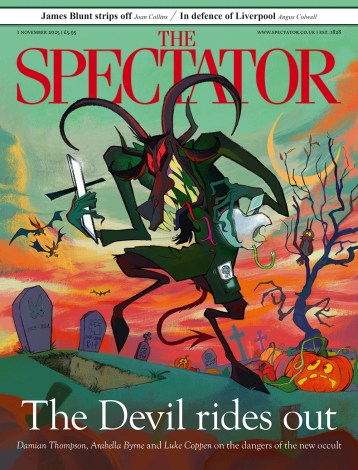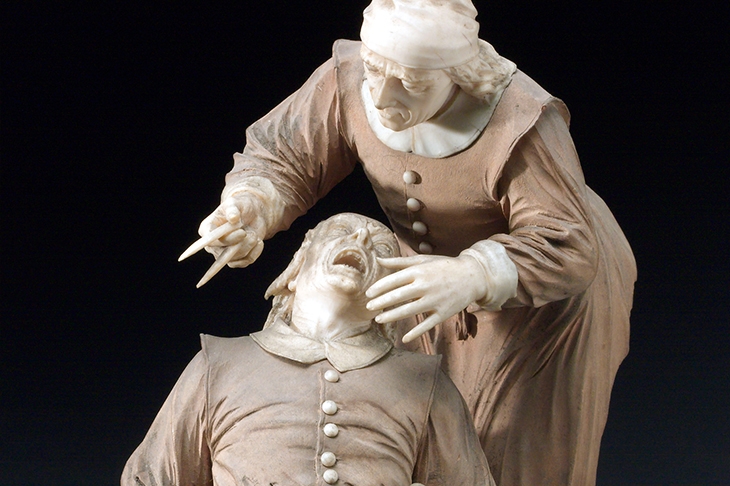In his Physiognomische Fragmente, published between 1775 and 1778, the Swiss physiognomist Johann Kaspar Lavater insisted that ‘clean, white and well-arranged teeth … [show] a sweet and polished mind and a good and honest heart’, while rotten or misaligned teeth revealed ‘either sickness or else some melange of moral imperfection’. Whatever one might think of the notion that one can read human character directly from the face, Lavater reminds us that dentistry has never been just about teeth. Possession of a functional, pain-free mouth is a practical necessity — we all must breathe and eat and talk — but it is also central to our sense of self. Pain in the head can seem unbearably close to the core of who we are, and stinking breath or black teeth carry a stigma that is both peculiarly personal and entirely public.
Lavater’s text embodies a profound paradox in our attitudes to dentistry, one that lies at the heart of my latest book, The Smile Stealers, and a new exhibition at Wellcome Collection in London. Teeth uses more than 150 objects — cartoons and caricatures, amulets and dental chairs, ivory dentures and drills — to chronicle the shift from heroic and agonising extractions to contemporary preventative dentistry. But it also casts light on a startling series of hidden histories: beauty and ugliness, food and fashion, cultural ideals and individual unease. Ask anyone to list the markers of medical progress, and the odds are that modern dentistry will be high on their list. Ask them to name the most unsettling moments in 20th-century cinema, and they’re likely to recall the notorious scene from Marathon Man, released in 1976, in which Laurence Olivier straps Dustin Hoffman into a dental chair and tries to extract a confession with a pick and a drill.
Societies in most times and places have had specialists to maintain, repair, extract or replace bad teeth — but to call this disparate collection of practitioners ‘dentists’ is to miss the very particular history and meaning of the name. The dentistes who emerged in Paris at the end of the 17th century built a new professional identity around this contradictory mixture of aspiration and fear. Men like Pierre Fauchard figured themselves as distinctively modern: armed with the very latest tools and techniques for creating la bouche orneé, but also attentive to the sensibility and suffering of their well-to-do patients. In doing so they framed their predecessors as brutal, illiterate swindlers — though the differences between Fauchard, sometimes called the first dentist, and his exact contemporary, Le Grand Thomas, the last of the great Parisian charlatans, were not as clear as either would have wished. Fauchard himself began his career as an itinerant tooth-puller, and the triumph of the dentiste was in great part a matter of skilful rhetoric and sharp professional boundary work.
From one perspective, Fauchard and the dentistes were simply tooth-pullers on the make, riding the coat-tails of the French surgical revolution and finding their fortunes in the mouths of the Parisian haute bourgeoisie. They claimed to combine a new kind of theoretical knowledge with practical expertise, offering less painful and more effective treatment based on conservation and maintenance of the teeth, with extraction as an undesirable last resort. But they were also genteel and discreet, dressing in the latest fashions and working in private clinics or the houses of their wealthy patients. In their writings they depicted Le Grand Thomas and the charlatans as fakers and butchers and, most of all, as yesterday’s men — fit, perhaps, for a medieval world of sieges and plagues, but hardly appropriate for the stylish, well-educated Parisians of the Enlightenment. Fauchard intended ‘dentiste’ to be a term of distinction in both senses: a celebration, but also a decisive break with the past.
As the acknowledged leaders of Enlightenment fashion, the dentistes inspired imitation in cities all over Europe. From the 1750s English tooth-pullers began to call themselves ‘dentists’ (just as English man-midwives had adopted the French accoucheur). But they were also the first generation of dental practitioners to be consulted by people who were not necessarily suffering acute pain. Much of what the dentistes promised would be entirely familiar to the patients of any modern orthodontist: the perils of the ugly mouth in a society obsessed with surfaces, the suffering endured in pursuit of a beautiful smile. And the subsequent story of dentistry, unlike that of surgery, was no meteoric rise to status and success. European and American dentists spent much of the 19th and 20th centuries embroiled in a series of arguments over their position within (or outside) medicine, and their troublesome relationship with the state.
Over four centuries and more our relationship with our teeth has changed radically. We expect them to remain strong, beautiful and useful throughout our lives, so long as we fulfil our side of the bargain by keeping them clean and well-maintained. When they cause us pain or practical difficulties, we visit a member of a respected and regulated profession, one that has — with great difficulty — gained parity with physicians and surgeons. Many children and adolescents will spend a decade or more in and out of dental surgeries, having braces fitted and tightened, so that as adults their smile will fulfil a cultural expectation of pearly perfection. Like previous generations we buy toothbrushes and toothpastes and mouthwashes, and worry about bad breath and crooked teeth. Unlike our predecessors we expect our dental care to be painless and effective. This 21st-century version of la bouche orneé is a world away from the experiences of most of our ancestors, their teeth worn down by millstone grit in bread or eroded by cheap sugar.
In terms of technical ability, 21st-century dentistry is better than anything that has come before — but the dental health of the world’s poor, even in the wealthiest nations, is declining. In an era of unprecedented wealth and continual crisis, of astonishing achievements in scientific medicine and growing global health inequality, dentistry remains a potent and troubling symbol of all that lies behinda healthy, happy smile.






Comments